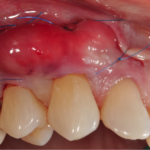
Aesthetic considerations are leading to an increase in demand for periodontal and peri-implant plastic surgery. Free gingival graft and connective tissue graft are frequently used and seem to produce predictable results. Pain and discomfort in the palate are common postoperative complaints. Cyanoacrylate tissue adhesive has been reported to reduce morbidity because of haemostasis, tissue adhesion, and its bacteriostatic capacity.
The aim of this review was to assess the effect of cyanoacrylate tissue adhesive in the management of palatal wound healing and post-operative pain after epithelialised gingival graft harvesting
Methods
Searches were conducted in the Cochrane, LILACS (Latin American and Caribbean Health Sciences), Medline/PubMed, Scopus, Web of Science. ProQuest Dissertations and Thesis, Google Scholar, and OpenGrey databases with no language or date restrictions up to June 2020. Randomized clinical trials (RCTs) in patients aged 18 or older undergoing surgical removal of palatal tissue for a graft with cyanoacrylate tissue adhesive in the test group, and another method in the control group were considered. Two reviewers independently screened, selected, and abstracted data from the studies. Risk of bias was assessed independently by two reviewers using the Joanna Briggs Institute Critical Appraisal Checklist for RCTs . Outcome measures included, postoperative pain, analgesic consumption, willingness to retreatment and wound healing score. A narrative summary of the findings was presented.
Results
- 4 studies involving a total of 144 patients were included.
- All 4 studies were considered to be at low risk of bias.
Free gingival graft (FGG) harvesting technique
- 4 studies evaluated postoperative pain – Cyanoacrylate tissue adhesive (CTA) used with haemostatic sponge stabilised with suture promoted less postoperative palatal pain than haemostatic sponge stabilised with suture, and periodontal dressing and suture, CTA and suture and suture alone.
- Analgesic consumption was measured in 2 studies find reduced usage with CTA used with haemostatic sponge.
- 2 studies assessed wound healing finding that CTA associated with a haemostatic agent showed more complete epithelisation than CTA and wet gauze.
- 2 studies reported greater willingness for retreatment with the CTA and haemostatic sponge.
Connective tissue graft (CTG) harvesting technique
- Similar levels of postoperative pain were seen with CTA alone or suture alone (1 study).
- Analgesic consumption was similar with CTA alone or suture alone (1 study).
- Wound healing was also similar for CTA and suture (1 study).
Conclusions
The authors concluded: –
Based on the low certainty level, cyanoacrylate tissue adhesive seems to promote less postoperative pain and analgesic consumption than wet gauze and suture regarding FGG. Additionally, cyanoacrylate tissue adhesive appears to increase the effect of haemostatic sponge, contributing to the reduction of postoperative pain and analgesic consumption. Concerning CTG, cyanoacrylate tissue adhesive seems to promote similar postoperative pain, analgesic consumption, and willingness for retreatment than the suture.
Comments
The authors have followed a standard systematic review process to address their clinical question. Only 4 small studies involving a total of 144 patients met the inclusion criteria although the overall risk of bias assessment considered all 4 to be at low risk of bias. However, the individual studies evaluated a number of different techniques with one including 5 different approaches. The studies used a range of outcome measures with only postoperative pain being common to all 4 studies. Consequently, agreement of common outcome measures (COMET) including patient reported outcomes would be helpful for future studies in this area. While the findings of this review suggest a potential benefit with CTA both the quantity and quality of the available evidence is very limited. New trials should of appropriate size, well designed and conducted and reported in line with SPIRIT and CONSORT guidelines .
Links
Primary Paper
Escobar M, Pauletto P, Benfatti CAM, Cruz ACC, Flores-Mir C, Henriques BAPC. Effect of cyanoacrylate tissue adhesive in postoperative palatal pain management: a systematic review. Clin Oral Investig. 2021 Jun;25(6):3609-3622. doi: 10.1007/s00784-020-03683-w. Epub 2020 Nov 17. PMID: 33200283.
Other references
Dental Elf – 2nd Oct 2019
Gingival recession: Stability of root coverage procedures for single gingival recessions
Picture Credits
By Funkynatsuki – Own work, CC BY-SA 4.0
